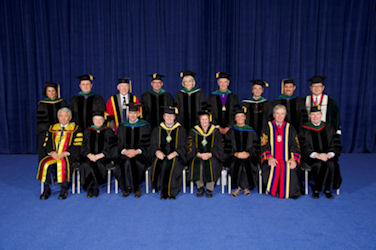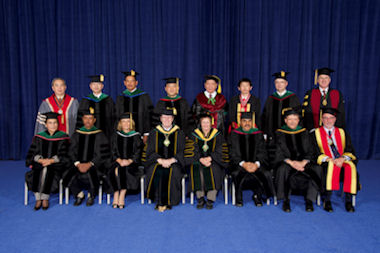- ACP Internal Medicine 2013 Highlights
- Photos from Internal Medicine 2013
- New International ACP Masters
- International Fellowship Exchange Program Awardees
- ACP Leaders on the Road: Bangladesh
- Update Your Knowledge with MKSAP 16 Q & A
- Future Worldwide Internal Medicine Meetings
- Highlights from ACP Internist and ACP Hospitalist
- College Corner
- Email Page to a Colleague
ACP Internal Medicine 2013 Highlights
San Francisco, California
Internal Medicine 2013, ACP's premier annual meeting, was held in San Francisco, California from April 11-13, 2013 and had an attendance of over 8,000 physicians. The event featured more than 260 workshops, lectures, panel discussions, and interactive courses for doctors of internal medicine and its subspecialties.
At the Convocation ceremony on April 11, approximately 500 physicians were inducted as ACP Fellows and recognized for their medical scholarship and achievement. Individuals and organizations were presented with nineteen awards in recognition of their contributions to the science and practice of medicine. Forty-seven Masterships were presented, and the College bestowed Honorary Fellowships to fifteen presidents of international internal medicine societies.
Following the ceremony, members, friends, and families gathered at the annual ACP International Reception that included over 300 international internal medicine leaders and attendees along with ACP leaders. During the reception, David L. Bronson, MD, MACP, ACP President, gave a few words to welcome everyone. International Fellowship Exchange Program (IFEP) awardees were also recognized and honored at this event.
ACP was honored to host presidents and representatives of internal medicine societies from around the world. The international delegates were part of the stage party in the Convocation ceremony. They also participated in ACP's 7th Annual International Forum, entitled "Global Healthcare Reform: Challenges, Triumphs, and Failures". The Forum provided an opportunity for ACP leaders and the presidents and special representatives from international internal medicine societies to discuss this important topic that crosses national boundaries and affects the health care of people around the world.
On Saturday, April 13, new ACP officers started their terms. Molly Cooke, MD, FACP, of San Francisco, California, became the 2013-2014 ACP President; Charles Cutler, MD, FACP, of Norristown, Pennsylvania, became the 2013-2014 Chair of the Board of Regents; David A. Fleming, MD, MA, FACP, of Columbia, Missouri, became the ACP President-elect; and Robert M. Centor, MD, FACP, of Huntsville, Alabama, became the Chair-elect of the Board of Regents.
Internal Medicine 2014 will be held April 10-12, 2014 in Orlando, Florida.
Honorary Fellows

Left to right, back row: Dr. Pilar Roman Sanchez, President, Spanish Society of Internal Medicine; Dr. Tomasz J. Guzik, President, Polish Society of Internal Medicine; Dr. Francis Dunn, President, Royal College of Physicians and Surgeons of Glasgow; Dr. Dror Dicker, President, Israel Society of Internal Medicine; Dr. Elisabeth Maerker-Hermann, President, German Society of Internal Medicine; Dr. John Crowe, President, Royal College of Physicians of Ireland; Dr. Rodolfo Bado, President, International Society of Internal Medicine; Dr. Idrus Alwi, President, Indonesian Society of Internal Medicine; Dr. Donald K. T. Li, President, Hong Kong Academy of Medicine.
Left to right, front row: Dr. Kriang Tungsanga, President, Royal College of Physicians of Thailand; Dr. Maria Domenica Cappellini, President, European Federation of Internal Medicine; Dr. Frank H. Bosch, President, Netherlands Association for Internal Medicine; Dr. David Bronson, 2012-13 ACP President; Dr. Phyllis Guze, 2012-13 Chair, ACP Board of Regents; Dr. Hanne Thurmer, President, Norwegian Society of Internal Medicine; Dr.Cecil H. Rorabeck, President, Royal College of Physicians and Surgeons of Canada; Dr. Richard Ceska, President, Czech Society of Internal Medicine.
Special Representatives

Left to right, back row: Dr. Lim Shih Hui, Master, Academy of Medicine, Singapore; Dr. Pei-Ming Yang, President, Taiwan Society of Internal Medicine; Dr. Eric Ulloa, President, Panamanian Society of Internal Medicine; Dr. Yeul Hong Kim, Chair of the IT & PR Committee, Korean Association of Internal Medicine; Dr. Oscar T. Cabahug, President, Philippine College of Physicians; Dr. Alan Ng Wei Keong, President, College of Physicians of Singapore; Dr. Margus Lember, President, Estonian Society of Internal Medicine; Dr. Neil Dewhurst, President, Royal College of Physicians of Edinburgh.
Left to right, front row: Dr. Eddy Luz Juarez, Secretary General, Peruvian Society of Internal Medicine; Dr. H.A.M. Nazmul Ahasan, President, Bangladesh Society of Medicine; Dr. Margarita Gaset, President, Buenos Aires Society of Internal Medicine; Dr. David Bronson, 2012-13 ACP President; Dr. Phyllis Guze, 2012-13 Chair, ACP Board of Regents; Dr. A. Muruganathan, President, Association of Physicians of India; Dr. Hans-Peter Kohler, Secretary General, International Society of Internal Medicine; Dr. Leslie E. Bolitho, President, Royal Australasian College of Physicians.

